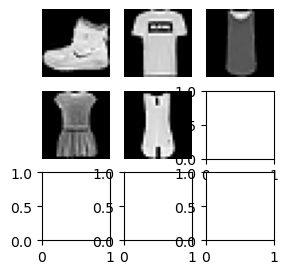!pip list | grep fastAIcourse
!pip list | grep datasetsfastAIcourse 0.0.91 /home/ben/BENEDICT_Only/Benedict_Projects/Benedict_ML/fastAIcourse
datasets 2.14.4
datasetsforecast 0.0.8Benedict Thekkel
fastAIcourse 0.0.91 /home/ben/BENEDICT_Only/Benedict_Projects/Benedict_ML/fastAIcourse
datasets 2.14.4
datasetsforecast 0.0.8Fashion-MNIST is a dataset of Zalando's article images—consisting of a training set of
60,000 examples and a test set of 10,000 examples. Each example is a 28x28 grayscale image,
associated with a label from 10 classes. We intend Fashion-MNIST to serve as a direct drop-in
replacement for the original MNIST dataset for benchmarking machine learning algorithms.
It shares the same image size and structure of training and testing splits.
{'image': Image(decode=True, id=None),
'label': ClassLabel(names=['T - shirt / top', 'Trouser', 'Pullover', 'Dress', 'Coat', 'Sandal', 'Shirt', 'Sneaker', 'Bag', 'Ankle boot'], id=None)}{'train': SplitInfo(name='train', num_bytes=31296607, num_examples=60000, shard_lengths=None, dataset_name='fashion_mnist'),
'test': SplitInfo(name='test', num_bytes=5233810, num_examples=10000, shard_lengths=None, dataset_name='fashion_mnist')}DatasetDict({
train: Dataset({
features: ['image', 'label'],
num_rows: 60000
})
test: Dataset({
features: ['image', 'label'],
num_rows: 10000
})
}){'image': <PIL.PngImagePlugin.PngImageFile image mode=L size=28x28>,
'label': 9}([<PIL.PngImagePlugin.PngImageFile image mode=L size=28x28>,
<PIL.PngImagePlugin.PngImageFile image mode=L size=28x28>,
<PIL.PngImagePlugin.PngImageFile image mode=L size=28x28>,
<PIL.PngImagePlugin.PngImageFile image mode=L size=28x28>,
<PIL.PngImagePlugin.PngImageFile image mode=L size=28x28>],
[9, 0, 0, 3, 0])ClassLabel(names=['T - shirt / top', 'Trouser', 'Pullover', 'Dress', 'Coat', 'Sandal', 'Shirt', 'Sneaker', 'Bag', 'Ankle boot'], id=None)(torch.Size([16, 1, 28, 28]),
tensor([9, 0, 0, 3, 0, 2, 7, 2, 5, 5, 0, 9, 5, 5, 7, 9]))tds = train.with_transform(transforms)
dl = DataLoader(tds, batch_size=16)
b = next(iter(dl))
b[x].shape,b[y](torch.Size([16, 1, 28, 28]),
tensor([9, 0, 0, 3, 0, 2, 7, 2, 5, 5, 0, 9, 5, 5, 7, 9])){'a': [tensor([1, 3])], 'b': [tensor([2, 4])]}dlf = DataLoader(tdsf, batch_size=4, collate_fn=collate_dict(tdsf))
xb,yb = next(iter(dlf))
xb.shape,yb(torch.Size([4, 784]), tensor([9, 0, 0, 3]))@fc.delegates(plt.Axes.imshow)
def show_image(im, ax=None, figsize=None, title=None, noframe=True, **kwargs):
"Show a PIL or PyTorch image on `ax`."
if fc.hasattrs(im, ('cpu','permute','detach')):
im = im.detach().cpu()
if len(im.shape)==3 and im.shape[0]<5: im=im.permute(1,2,0)
elif not isinstance(im,np.ndarray): im=np.array(im)
if im.shape[-1]==1: im=im[...,0]
if ax is None: _,ax = plt.subplots(figsize=figsize)
ax.imshow(im, **kwargs)
if title is not None: ax.set_title(title)
ax.set_xticks([])
ax.set_yticks([])
if noframe: ax.axis('off')
return axHelp on function show_image in module __main__:
show_image(im, ax=None, figsize=None, title=None, noframe=True, *, cmap=None, norm=None, aspect=None, interpolation=None, alpha=None, vmin=None, vmax=None, origin=None, extent=None, interpolation_stage=None, filternorm=True, filterrad=4.0, resample=None, url=None, data=None)
Show a PIL or PyTorch image on `ax`.
@fc.delegates(plt.subplots, keep=True)
def subplots(
nrows:int=1, # Number of rows in returned axes grid
ncols:int=1, # Number of columns in returned axes grid
figsize:tuple=None, # Width, height in inches of the returned figure
imsize:int=3, # Size (in inches) of images that will be displayed in the returned figure
suptitle:str=None, # Title to be set to returned figure
**kwargs
): # fig and axs
"A figure and set of subplots to display images of `imsize` inches"
if figsize is None: figsize=(ncols*imsize, nrows*imsize)
fig,ax = plt.subplots(nrows, ncols, figsize=figsize, **kwargs)
if suptitle is not None: fig.suptitle(suptitle)
if nrows*ncols==1: ax = np.array([ax])
return fig,axsubplots (nrows:int=1, ncols:int=1, figsize:tuple=None, imsize:int=3, suptitle:str=None, sharex=False, sharey=False, squeeze=True, width_ratios=None, height_ratios=None, subplot_kw=None, gridspec_kw=None, **kwargs)
A figure and set of subplots to display images of imsize inches
| Type | Default | Details | |
|---|---|---|---|
| nrows | int | 1 | Number of rows in returned axes grid |
| ncols | int | 1 | Number of columns in returned axes grid |
| figsize | tuple | None | Width, height in inches of the returned figure |
| imsize | int | 3 | Size (in inches) of images that will be displayed in the returned figure |
| suptitle | str | None | Title to be set to returned figure |
| sharex | bool | False | |
| sharey | bool | False | |
| squeeze | bool | True | |
| width_ratios | NoneType | None | |
| height_ratios | NoneType | None | |
| subplot_kw | NoneType | None | |
| gridspec_kw | NoneType | None | |
| kwargs |
fig,axs = subplots(3,3, imsize=1)
imgs = xb[:8]
for ax,img in zip(axs.flat,imgs): show_image(img, ax)
–checking
def get_grid(
n:int, # Number of axes
nrows:int=None, # Number of rows, defaulting to `int(math.sqrt(n))`
ncols:int=None, # Number of columns, defaulting to `ceil(n/rows)`
title:str=None, # If passed, title set to the figure
weight:str='bold', # Title font weight
size:int=14, # Title font size
**kwargs,
): # fig and axs
"Return a grid of `n` axes, `rows` by `cols`"
if nrows: ncols = ncols or int(np.floor(n/nrows))
elif ncols: nrows = nrows or int(np.ceil(n/ncols))
else:
nrows = int(math.sqrt(n))
ncols = int(np.floor(n/nrows))
fig,axs = subplots(nrows, ncols, **kwargs)
for i in range(n, nrows*ncols): axs.flat[i].set_axis_off()
if title is not None: fig.suptitle(title, weight=weight, size=size)
return fig,axsdef show_images(ims:list, # Images to show
nrows:int|None=None, # Number of rows in grid
ncols:int|None=None, # Number of columns in grid (auto-calculated if None)
titles:list|None=None, # Optional list of titles for each image
**kwargs):
"Show all images `ims` as subplots with `rows` using `titles`"
axs = get_grid(len(ims), nrows, ncols, **kwargs)[1].flat
for im,t,ax in zip_longest(ims, titles or [], axs): show_image(im, ax=ax, title=t)